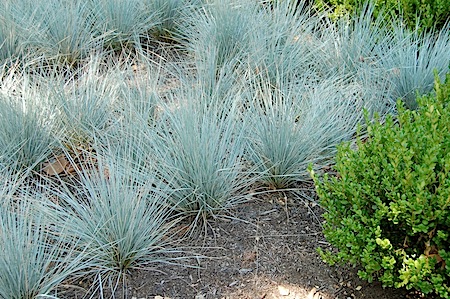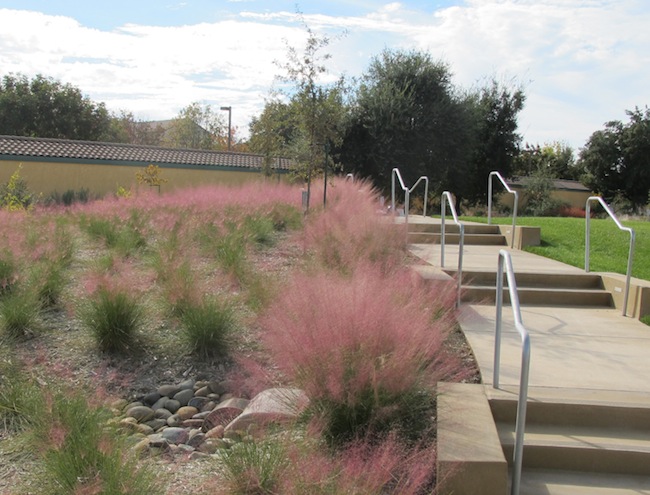Ornamental Grasses Add Dimension to Your Garden
By Pat Dickey, Fairfax Master Gardener

Helictotrichon sempervirens
Once thought to be too informal and wild for the residence garden, ornamental grasses have grown in popularity in recent times. Homeowners are discovering that the beauty and longevity of grasses add a refreshing change to their gardens.
As members of the true grass family, Poaceae, ornamental grasses are monocots — having only one cotyledon or seedling leaf. Their stems are hollow and grow from the plant base rather than from the tip. This type of growth gives them the ability to stand erect. Many grasses that are popular in residential gardens are bunching grasses that grow in clumps and do not spread by rhizomes.
Ornamental grasses were first used with perennials in the landscape by Karl Foerster in postwar Germany, and interest spread westward. Foerster saw the value of using grasses of various shapes, sizes and colors to achieve a naturalistic look that lasted throughout the year. Grasses give the garden lush foliage and color, followed by flowers called inflorescences. They can also provide structural winter interest and a refuge for birds and wildlife.

Muhlenbergia capillaris
When grasses are introduced into a garden, they add texture and needed height to the design. They give graceful movement to the garden when they are caught by gentle breezes. Ornamental grasses can be planted separately as specimen plants, or in multiples of three or more in a border or mass planting. They should be planted to allow for growth, in most cases as far apart as they are tall. Many varieties can also be striking focal points in containers.
For gardeners, the best features of many ornamental grasses are their low maintenance and their ability to adapt to different soil conditions. Cool-season types remain semi-evergreen throughout the winter, with foliage growth in the fall and flowers in the spring and early summer. Some cultivars are smaller than the warm-season varieties and require regular division. Warm-season varieties grow when the weather is warm in late spring and flower in late summer and fall. Foliage should remain on the plant throughout the winter to protect the crown and then be trimmed 3 to 10 inches from the ground in early spring.
Cool-season grasses suitable for our area:
- Blue fescue (Festuca glauca), a semi-evergreen grass, does best in well-drained soil and full sun. Arching flower stems add height to 16 inches. Use it as a specimen, as a ground cover, or in a border. Space plants to allow for sufficient air movement. ‘Elijah Blue,’ the most durable cultivar, has soft, silvery-blue leaves.

Calamagrostis x acutiflora
- Feather reed grass (Calamagrostis x acutiflora) prefers average to wet soil and afternoon shade and grows to 6 feet. It is well-suited for rain gardens and can be planted singly or in groups. The cultivar ‘Karl Foerster’ has purple-pink inflorescences in early summer and a buff coloring by August. It grows fast and can be used as a fine deciduous screen.
- Blue oat grass (Helictotrichon sempervirens) is semi-evergreen with blue foliage and stiff, spiky flowers in early summer, growing to 3 feet. It has distinctly ribbed leaves and showy, arching, one-sided flower heads. It prefers full sun and average to dry soil. Plant it as a specimen or in a group. One cultivar, ‘Sapphire,’ has wider leaf blades and better tolerates heat and humidity.
- Purple moor grass (Molinia caerulea) is very slow growing. It can reach 3 feet high and does well in full morning sun and afternoon shade. Airy flowers are yellowish to purple and appear in summer. It prefers moist, acidic fertile soil. Plant it with hostas, azaleas and other acid lovers. It is suitable for rain gardens. ‘Variegata’ has a cream stripe on the leaves.
- Tufted hair grass (Deschampsia cespitosa) is semi-evergreen and prefers rich, moist soil in part shade. It grows to 3 feet, with airy panicles blooming in early summer. Plant it with hostas and shade lovers. ‘Northern Lights’ has creamy white and gold variegated foliage and soft flowers and a height of 2 feet. ‘Schottland’ has tan to silver flowers, towering to 4 feet.
Warm-season grasses to try:
- Pink muhly grass (Muhlenbergia capillaris) prefers full sun and blooms in late summer on 4-foot stalks. It is most showy in September and October with its display of pink flowers. It is drought and wind tolerant and best planted in large clumps. ‘White Cloud’ produces clouds of white flowers.
- Fountain grass (Pennisetum alopecuroides) is adaptable to dry and wet soils in sun to part shade. Bottlebrush silvery white flowers appear in August and September, followed by bronze leaf color. It can be planted as a specimen or mass and is good for rain gardens. Dwarf cultivars of 1 to 2 feet are ‘Piglet,’ ‘Little Bunny’ and ‘Little Honey.’ ‘Foxtrot’ grows to 5 feet with smoky-rose bottlebrush flowers and a white “fox’s tail” on the tips.

Shade tolerant Hakonechloa macra
- Switch grass (Panicum virgatum) has a stiff, vertical 3- to 6-foot form but becomes floppy in rich soil. It grows in sun to part shade and dry to wet soils. Its blue-green leaves turn yellow to orange in fall. The flowers look like an airy cloud. It is good in rain gardens and planted in clumps. ‘Heavy Metal’ has pinkish blooms and metallic blue leaves, turning yellow in the fall. ‘Prairie Sky’ exhibits blue leaves and dark red panicles. ‘Northwind’ has one of the best vertical forms with olive green to bluish foliage.
- Little bluestem (Schizachyrium scoparium) is a native grass growing to 2 to 4 feet. It has slender green leaves with a tinge of blue at the base and provides bronze-orange fall color. Purplish-bronze blooms form in August. It prefers full sun and average to dry soil. One cultivar, ‘The Blues’, has paler blue leaves that turn burgundy-red in the fall.
- Golden hakone grass (Hakonechloa macra) is a shade-loving grass that prefers moist, rich soil. Its cascading, arching leaves have gold striping. It grows to 1 to 2 feet and is good as a specimen or in containers. ‘Albo Striata’ has creamy white and green striping.
References
The Encyclopedia of Grasses for Livable Landscapes, 2007, by Rick Darke
Herbaceous Perennial Plants, 3rd edition, by Allan M. Armitage
Ornamental Grasses and Grass-Like Plants, Clemson Cooperative Extension
Ornamental Grasses for Shady Sites, University of Minnesota Extension
Native Ornamental Grasses, Cornell University Essex County
Ornamental and Native Grasses for the Landscape, Mikaela Boley, University of Maryland Extension
. . . updated 2022